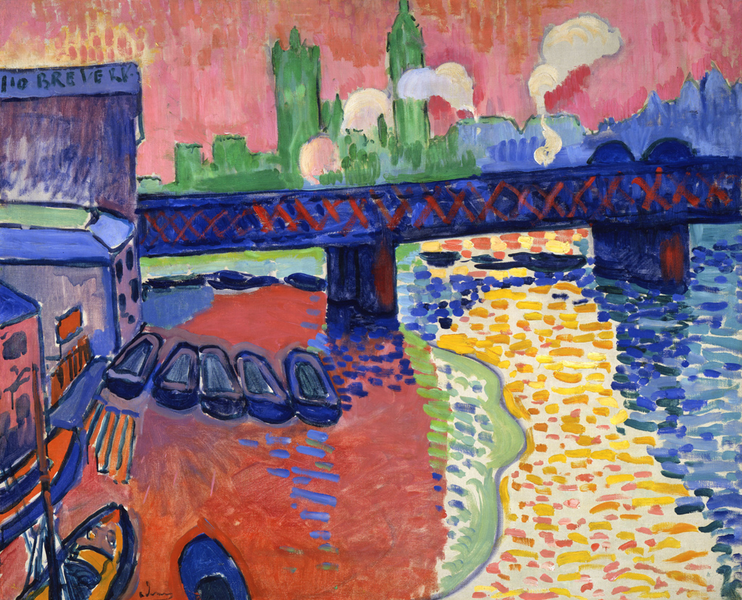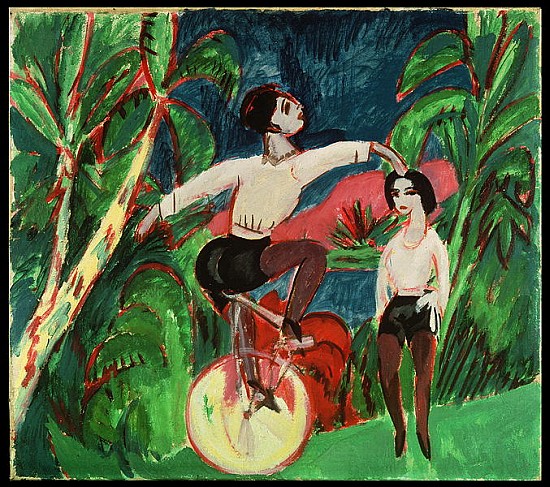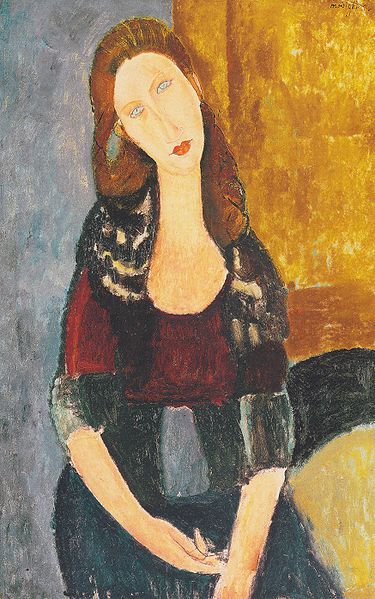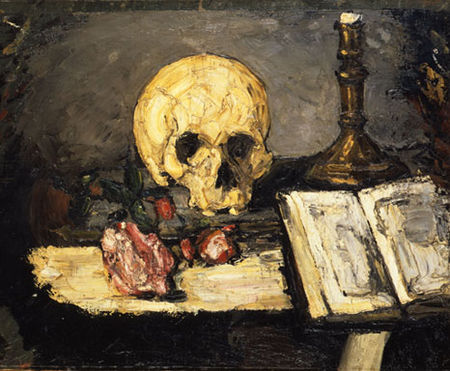The Israel Museum, Jerusalem, showcased Fauve and Expressionist paintings from one of the world’s most notable private collections of modern art in the exhibition Color Gone Wild: Fauve and Expressionist Masterworks from the Merzbacher Collection. On view July 6, 2013-January 11, 2014, the exhibition featured works by major Fauve and Expressionist artists from high points in their careers, including paintings by Georges Braque, André Derain, Alexej Jawlensky, Wassily Kandinsky, Henri Matisse, and Maurice Vlaminck, among others. Fifteen years following the collection’s public debut at the Israel Museum, Color Gone Wild provided a focused examination of forty-two collection highlights, including important works acquired since then, all linked by a vivid use of vibrant color as a vehicle for emotional expression.
“Since its first public presentation at the Israel Museum in 1998, the Merzbacher Collection has been universally embraced for its exceptional quality, comprising paintings that trace the history of color in the 20th century,” said James S. Snyder, the Anne and Jerome Fisher Director of the Israel Museum. “The works on view in Color Gone Wild are linked by their intensity of color and their emotional expressiveness—reflecting Werner and Gabrielle Merzbacher’s persisting passion for collecting artworks by some of the most pioneering artists of the 20th century. We are deeply grateful to the Merzbachers for making the presentation of this extraordinary display possible.”
Color Gone Wild reflects the Merzbachers’ aesthetic passions. Their interest in collecting was spurred initially by Mrs. Merzbacher’s grandparents, staunch supporters of the avant-garde who amassed a small but stunning collection of modern art. The modern masterpieces on view in this presentation are unified by their brilliantly contrasting hues and energized brushwork. Though differing in subject matter, the paintings all demonstrate a freedom from the social and artistic conventions of their time and a vision of art as socially and spiritually transforming. The exhibition opens with Fauve painting, leading then to the two groups of Expressionists, The Bridge (Die Brücke) and the Blue Rider (Der Blaue Reiter), emphasizing the contemporaneous preoccupation of these painters with expressive color, bold brushstrokes, and innovative composition.
Included in the exhibition were two keystones of the Merzbacher collection:

Blooming Trees (1909) by Karl Schmidt Rottluf and

Interior at Collioure (1905) by Henri Matisse.
The acquisition of Blooming Trees marked a significant break in the Merzbachers’ earlier collecting practice, which initially favored works by Social Realists and colorful Impressionists. Shortly thereafter, the arrival on loan from Mrs. Merzbacher’s parents of Matisse’s Interior at Collioure further established the foundation for the Merzbachers’ new collecting focus and fueled their search for seminal Fauve and Expressionist works, as well as paintings from related art movements.
Approximately one quarter of the works in Color Gone Wild were purchased following the collection’s public debut in 1998 and had never been seen in Israel. Among the newly acquired works in the exhibition was

Wassily Kandinsky’s Two Hoursemen and a Lying Person (1909-1910),
an early work that demonstrates the artist’s inclination towards abstraction with its bold simplification of figures and heightened use of color.
Also on view were

Girl with Cat (1910) and

Two Nudes on a Blue Sofa (1910-20) by Ernst Ludwig Kirchner,
which in their crude, non-naturalistic depictions of contemporary bohemian life reflect the artist’s attempts to break from the traditional academic style of the age.
Another work that marks a shift in artistic practice is

Maurice de Vlaminck’s Potato Pickers (ca. 1905-07),
an example of the artist’s trend towards “deconstructing” the physical landscape into violent streaks of color that convey a sense of motion. The exhibition also showcased newly acquired paintings by Erich Heckel, Emil Nolde, and Max Beckmann.
Color Gone Wild was on view within the Museum’s collection galleries, as a preamble to its permanent display of the art of the 20th century. The exhibition is an extension of a longstanding relationship between the Israel Museum and the Merzbachers, dating back to Mr. Merzbacher’s extended term as the Founding President of the Swiss Friends of the Israel Museum. In 1986, the Merzbacher’s gifted the Dr. Julius and Hilde Merzbacher Gallery for Israeli Art.

Max Pechstein (German, 1881–1955), “The Red Bathhouse,” 1910, oil on canvas. ©The Werner and Gabrielle Merzbacher Collection
Curator: Color Gone Wild was curated by Dr. Adina Kamien-Kazhdan, David Rockefeller Curator, The Stella Fischbach Department of Modern Art at the Israel Museum.
From a very nice article about the Merzbachers and the show in the NY Times (images added):
After seeing an exhibition of Kandinsky's paintings at the Leonard Hutton Galleries in Manhattan in the early 1960's, he put that Russian-born artist at the top of his wish list. And eventually, years later, he acquired seven Kandinskys, one by one, from a critical point in his career. Viewed together, the oil paintings seem to show Kandinsky's movement from landscapes to abstraction.
But each Kandinsky painting was like a slippery eel that got away just as he pounced. One,
''Section for Composition II,''
was repeatedly put on the market and snatched back by an indecisive owner. Seven years after Mr. Merzbacher first tried to buy it, it appeared on the cover of an auction catalogue.
''I thought, 'Oh, this time I really want to get it,' but the owner changed his mind again,'' Mr. Merzbacher said. ''The auction house told him he couldn't; it was on their cover. So they put a very high limit and thought they wouldn't sell it. But I wanted it. For me it is not a mental difficulty to pay more than the market value for something I really want.''
This was in the late 1970's, before art prices skyrocketed, and Mr. Merzbacher said he paid $1 million. ''You wouldn't be seeing this exhibition if money was what was important,'' Mr. Merzbacher said. ''I have never bought art for money. I'm not displeased that it has not been a terrible investment, but that was not my motivation.''
Stephen S. Lash, the vice chairman of Christie's, called Mr. Merzbacher ''a collector's collector, whose collection bears the unmistakable imprint of the man himself.''
That collection is estimated to be worth several hundred million dollars. (A Modigliani similar to his
''Jeanne Hebuterne Sitting''
recently sold for $13 million.) He has not sold a painting in more than 20 years.
Previous shows:
"The Joy of Color", an exhibition of almost 150 pictures from the collection, first celebrated success in Jerusalem in 1998, followed by Japan in 2001, the Royal Academy in London in 2002, and Zurich's Kunsthaus in 2006. Further exhibitions were held at the Louisiana Museum in Denmark in 2010 and in 2012 at the Fondation Gianadda in Martigny, Switzerland (June 29 to November 25).
From an article about the Martigny show (some images added):
In 1964, around 15 years after leaving the country, the family relocates back to Switzerland with their three children. Werner Merzbacher joins international fur trading firm Mayer & Cie. It is his wife Gabrielle who leads him to discover art. In Ascona, she shows him the small, prestigious collection belonging to her grandfather, Bernhard Mayer.
Picasso's "The Couple",
Cézanne's "Skull",
Matisse's "Interior at Collioure (The Siesta)" (above)
now belong to the Merzbacher Collection, and at that time have a profound impact on him. "Although I never knew him, Bernhard Mayer became a very important part of my life". With his collection, his father-in-law gives him a major boost to his own collection.
Purchasing art is a question of economics, but in this case it's first and foremost a case of love. The spark is ignited in an exhibition on Fauvism at New York's Moma, following which the Merzbachers start acquiring works of art in the 1960s.
Wassily Kandinsky's "Murnau – Dorfstrasse", 1908,
is the first piece; the artist goes on to remain very much a center of attention.
Blue Balls
Lady with a Yellow Straw Hat
From an article about the Royal Academy show:
Werner Merzbacher was born in Germany in 1928. As the son of a highly respected country doctor who considered himself a German, like so many other Jews, Werner's life was destined to change course dramatically. After the warning signals of Kristallnacht, when Werner was 10 years old and no longer permitted to attend school, his parents took the precaution of sending him with a children's transport to Switzerland. A sympathetic Christian physician and colleague of his father took Werner in to live with his family. War broke out and the young boy never saw his parents again. They died in Auschwitz after being held in a concentration camp in France.
With the help of scholarships, Werner remained in Switzerland for 10 years, where he received his education. In 1949 he emigrated to the United States and met Gabrielle Mayer. In 1951 they were married...
In 1964 the Merzbachers returned to Switzerland with their three children...
Werner Merzbacher's dynamism and energy is visible in the works he has collected, which literally jump off the walls in the galleries. His passion for art knows no half measures, and art is deeply important to both him and his wife; their earliest purchases were made as newlyweds, when money was a factor.
"The Seine at Pecq," by Maurice de Vlaminck, oil on canvas, 86 by 118 centimeters, 1905
For a sense of "loosened-up," virtuoso Van Gogh brushwork, Vlaminck's "The Seine at Pecq" (1905), shown above, is an riot of palette-knifed cadmiums, acid greens and swirling black lines, reaching a crescendo in the blood-red buildings in the distance, which in reality must have been the drab muddy-browns and non-descript grays usually associated with small-town port architecture. In the artist's imagination, they are transformed by a unique interpretation in raw color squeezed directly from the tube.
The more soothing Fauve paintings in the second gallery, like Derain's "London Bridge," (1905-1906) and Vlaminck's stunning "View from Chatou" (1906), while still maximizing on the complimentary (discordant) greens and reds, owe more to the elegant spatial sensibilities of Matisse's "Interior at Collioure" (1905-1906), (above) which came to the collection through Bernard Mayer, Gabrielle Merzbacher's grandfather, in the 1920s.
"Landscape at L'Estaque" by Georges Braque, oil on canvas, 46 by 55 centimeters, 1906
Even in the dazzling company of the Vlaminck's and Derains in the second gallery, George Braque (1882-1963) holds his own with a sublime, rosy hued "Landscape at L'Estaque," (1906) and "Landscape at La Ciotat," (1907), a jewel of a painting worth kidnapping. The sinuous curves and sumptuous colors of his Fauve period give no hint whatsoever of the controlled color palette and intellectual rigor of the Cubist revolution that Braque, together with Picasso, later instigated. These works are like a joyous romp in a sun-drenched garden, the calm before the storm. Even though it is well known that Braque went through a Fauve period, his lyrical Fauve paintings come as a surprise because they are touchingly uninhibited, colorful and child-like. It made this viewer long for a gigantic retrospective of his work. (Editor: See Georges Braque: A Retrospective)
"Stars Above an Evil House," by Paul Klee, watercolor and sand on canvas, 19.7 by 22 centimeters, 1916
Later, while on military service, the mood becomes more menacing and the colors more somber in "Stars Above an Evil House (1916), shown above. "Moonrise-Sunset" (1919), is a sophisticated, exotic patchwork in oils of palm trees, turrets and rooftops beneath a starry sky. Suspended in the midst of this dark, tropical night is a full-blown yellow sun, which ignites the composition. Klee's magical paintings wash up on the shores of the imagination long after the show is left behind. Although Klee (1879-1940) was a supremely gifted artist, he took his time to develop. His discovery of color was a catalyst, and in 1914 he wrote in his diary "Color possesses me forever, I know. Color and I are one. I am a painter." It is no coincidence that Klee's paintings are placed alongside spectacular watercolors by Emile Nolde (1867-1956). Together with Derain and Vlaminck, the juxtaposition of Klee and Nolde - which accentuate their striking affinity - is the most memorable at the show. Nolde will be discussed later.
Early 20th century French art was almost exclusively the work of immigrant painters, represented in gallery two with works by Vlaminck, (Belgian), Picasso and Julio Gonzalez (1876-1942), (Spain), Jacques Lipschitz 1891-1973), (Lithuania), Amedeo Modigliani (1884-1920), Gino Severini (1883-1966) and Umberto Boccionni (1882-1916), (Italy), and Frantisek Kupka (1871-1957), the pioneer of abstract painting came from what was then the Hapsburg Empire. The exceptions were Fernand Léger (1881-1955), whose "Two Discs in the City" (1919), celebrate city life and the machine, and Sonia Delaunay Terk (1885-1979) whose "Le Bal Bullier" (1913) is reminiscent of Severini's high-velocity "The Plastic Forms of a Horse" (1913-14). Nearby, Severini's "The Speeding Car," (1912-13) is a reminder of the famous assertion in Marinetti's first Futurist Manifesto, (1909), that "a speeding racing car is more beautiful than the Victory of Samothrace," which must have endeared him to the curators of antiquities departments in museums around the world.
"Form of Yellow (Notre Dame)" by Frantisek Kupka, oil on canvas, 73 by 59.5 centimeters, 1911
Three remarkable Kupka's are a revelation, the most important being the musical "Form of Yellow, (Notre Dame)" (1911). "Study for a Fuge," (1912-19), and "Abstract Composition," (1913-19), are early examples of Kupka's series based on the cosmos, which bear an uncanny resemblance to the more recent work of the Abstract Expressionists, noticeably Clifford Still. There is no attempt in these paintings to be representational: they are uniquely "free-form" and the only purely abstract works in the show. Perhaps this is why Kupka is credited with being the pioneer of abstraction.
"Angel of the Last Judgement" by Vasily Kandinsky, oil on cardboard, 64 by 50 centimeters, 1911
Bernhard Mayer was not particularly interested in color theory and its exponents, though he did make a brave attempt to understand his friend and artist Arthur Segal (1875-1944), who is represented in the show by a canvas titled "Mayer & Co." (1919). While Goethe's color theories are not manifest in Segal's brown monotone painting, which possibly alludes to the Mayer fur enterprise, Vasily Kandinsky's (1866-1944) gorgeous and unusual "Section for Composition II" (1910) and exuberant "Angel of the Last Judgment" (1911), both shown above, not only pay homage to Goethe's color theories, but embody Kandinsky's own philosophy on color, as laid down in his great manifesto, "Concerning the Spiritual in Art," (1911), which accompanied these paintings. The magnificent Kandinskys at this show were added to the collection by Mayer's grandchildren, the Merzbachers.
Also represented are strong paintings by Russian Modernists, completed before the Russian Revolution of 1917. The original, personal styles of Natalia Goncharova (1881-1962) in "River Landscape" (1909-11), and especially "Dynamics of Color" (circa 1916-18) by Alexandra Exter (1882-1949), arrive at abstraction before anyone else was to do so, with the exception of
The third gallery is dominated by the vital and towering presence of Vasily Kandinsky, and includes other artists like Franz Marc 1880-1916), Paul Klee and Heinrich Campendock (1889-1957), commonly associated with Der Blau Rider, ("The Blue Rider'). Never a formal organization of artists, it was a name given to an illustrated anthology of essays on art and music, "The Blue Rider Almanac," edited by Kandinsky and Marc, published in 1912. They also organized two exhibitions in Munich in 1911 and 1913.
While the works displayed share (once again) a pre-occupation with non-naturalistic color, which has caused the artists to be mistakenly thought of as German Expressionist painters, there was never a unified Blue Rider "style," or a manifesto; the artists differed widely in subject and approach, as in Kandinsky's "Murnau Village Street" (1908) and Franz Marc's "Landscape with House, Dog and Cow" (1914), although the latter shows a strong affinity with Paul Klee's luminous, post-Tunisian "The Yellow House," also painted in 1914. Kandinsky's "Murnau-Kohlgruberstrasse" (1908), (above) which was painted in the countryside outside Murnau, south of Munich on the edge of the Alps, leans towards abstraction, which he accomplished by 1913. He and his partner, Gabrielle Munter (1877-1962), liked the area so much that she bought a house there. It was in Murnau that Kandinsky developed the pictorial language that evolved into his abstract compositions. The give-and-take between the artists becomes apparent in Kandinsky's gorgeous "Section for Composition II" (1930), (above) which shows the influence of Matisse. The artist even painted the frame of this highly decorative image.
"Autumn Landscape with Boats" by Vasily Kandinsky, oil on board, 71 by 96.5 centimeters, 1908
Between 1908 and 1913, Kandinsky's pre-occupation with non-naturalistic color developed from late Impressionist, Fauve-related landscapes like "Autumn Landscape with Boats" (1908), shown above, to the paintings mentioned earlier "Murnau the Garden II" (1910) and "Angel of the Last Judgment" (1911) which turned out to be crucial for twentieth-century painting. Nothing is directly represented in "Angel of the Last Judgment." The title alludes to the kind of image that may have inspired it, but nothing can be deciphered besides pure forms and colors.
Kandinsky learned a great deal from Alexej von Jawlensky (1864-1941), who liberated color from its traditionally descriptive paintings. Both artists were Russian and arrived in Munich to study art in 1896. Although they became friends, Jawlensky never joined any of the Blue Rider activities. However, Jawlensky's "Girl in a Gray Apron" (1909), reflects his knowledge of the Fauves, (as did Kirchner), in the interplay of red and green; black contour lines flatten the image and make it more decorative. The painting could have been painted from a model, but by the time Jawlensky painted "Saviour's Face" (1917), and "Mystical Head of a Girl" (1917), the subject is imaginary and spiritually inspired. By the time he painted "Abstract Head" in 1929, although a face is discernible, the artist insisted it is not a face: "It is that which closes itself downward, opens itself upward and encounters itself in the middle." By which he means the "inner" self. The "spiritual" in man and woman, was now manifest in art.
"Poppy" by Emil Nolde, gouache on paper, 44.5 by 36 centimeters
In these uniquely beautiful works, including "Poppy," (undated), shown above, and the exquisite duo of "Sunflowers," (undated), Nolde gives a nod to Van Gogh, whose sunflowers have become synonymous with the idea of a flower, and who, by painting them so often, bestowed upon the humble blossom a degree of importance previously absent from "haute" art. Nolde's sunflowers instantly draw comparison with Van Gogh's unique "Two Sunflowers," painted in the summer 1887, now in the collection of The Metropolitan Museum of Art, New York.
Other members of Die Brucke included Ernst Ludwig Kirchner (1880-1938), Erich Heckel (1883-1970), Karl Schmidt-Rottulf (1884-1976) and Fritz Bleyl. The group was founded in Dresden in 1905, its name "Die Brucke" borrowed from a Nietzsche quotation. Max Pechstein (1881-1956), together with Nolde, joined the group in 1906, and with the exception of Kirchner, all were self-taught. The purchase by Werner Merzbacher of Schmidt-Rottulf's "Blooming Trees," shown above, in 1919 marked a turning point in the collection; its wild handling and raw colors, which, once again, owe so much to Van Gogh, competed with the earliest paintings collected by Mayer, forcing the Merzbacher's to think differently about the works they acquired.
Landscape was essential to Die Brucke, and paintings like Erich Heckel's luscious "Houses in the Autumn," (1908) Kirchner's magical "Sertig Valley Landscape," (1924) and Max Pechstein's "The Red Bathhouse, (1910), while demonstrating their exposure to Fauvism, owe much more to Van Gogh. In Schmidt-Rottulf's "Gateway," (1910), however, there is a subtle shift. Despite the high-voltage color and the rapid brushwork, which were intended to assault the eye and disturb the mood (all traceable to Van Gogh) the pigment is thinner, and less textured. His individuality as a German Expressionist was asserting itself.
Eric Heckel's sultry "Group on Holiday," painted in 1909, must have raised an eyebrow or two amongst the monocled ladies and gents in the salon: anything less consistent with the principals of a classical life-drawing class would be hard to find. It is intentionally unsettling and discordant in the very best Van Gogh tradition, but the deft modeling and sophisticated use of black contours also allies it to Matisse, who called black "the queen of colors."
Kirchner's "Unicycle Rider" reveals an increasing interest in big-city subjects, such as street scenes and circus acts, and his palette became more restricted, although he continued to use color expressively.
Flowers, women, pet cats and dogs and mythological birds all find their way into Beckman's art. "Still Life with Red Roses and Butchy" (1942) refers to Butchy the pet Pekinese, who entered the family when Beckman married. This was on the condition that his wife never wish for children and promised to give up her budding career as a singer and violinist. In return, he had to give her red roses every single day. Well, artists are not the most predictable - or reasonable - individuals.
"Still Life with Mirror and Tiger Lilies" by Max Beckmann, oil on canvas, 76 by 61 centimeters, 1950
Beckman had plenty of takers for his "flower" paintings and still-lifes, which appealed to dealers and collectors more than his melancholy, mythological-allegorical figure paintings: "Still-Life with Mirror and Tiger Lilies" (1950), shown above, was picked up by Beckman's New York dealer Curt Valentin almost before the canvas had dried on the easel. This sophisticated painting is typical of Beckman's "Woman with Red Rooster," (1941) is an exotic "odalisque," in which the rooster suggests a glorious bird of paradise, which, frankly, would be far more "hip" and compatible with the elegant pose and attire of the reclining blond beauty on the sofa. The bird, like the woman, is sensually appealing; it is also a symbol of Beckman's more abstract ideas and concepts, some of them erotic.
"Bec de l'Aigle, La Ciotat," by Emile-Othon Friesz, oil on canvas, 65.5 by 81 centimeters, 1906-7
There are a great many spectacular paintings in this exhibition such as "Bec de L'Aigle, La Ciotat" by Emile-Othon Friesz, that resonate with dynamism and indelible imagery.
More images mentioned in the above article:

Derain "London Bridge," (1905-1906)

George Braque"Landscape at La Ciotat," (1907)

Natalia Goncharova "River Landscape" (1909-11)

Kandinsky "Murnau Village Street" (1908)

Franz Marc "Landscape with House, Dog and Cow" (1914),

Paul Klee "The Yellow House"

Kirchner "Sertig Valley Landscape" (1924)

Kirchner "Unicycle Rider"

Max Beckmann (German, 1884-1950): Woman with Red Rooster, 1941. Oil on canvas, 55 x 95 cm. Mr and Mrs Merzbacher, the Merzbacher Foundation and Carafe Investment Company. © DACS 2002 and

Eric Heckel"Group on Holiday," (1909)

"Florence: View from the Mannielli Tower" by Oskar Kokoschka, oil on canvas, 85.5 by 110 centimeters, 1948













